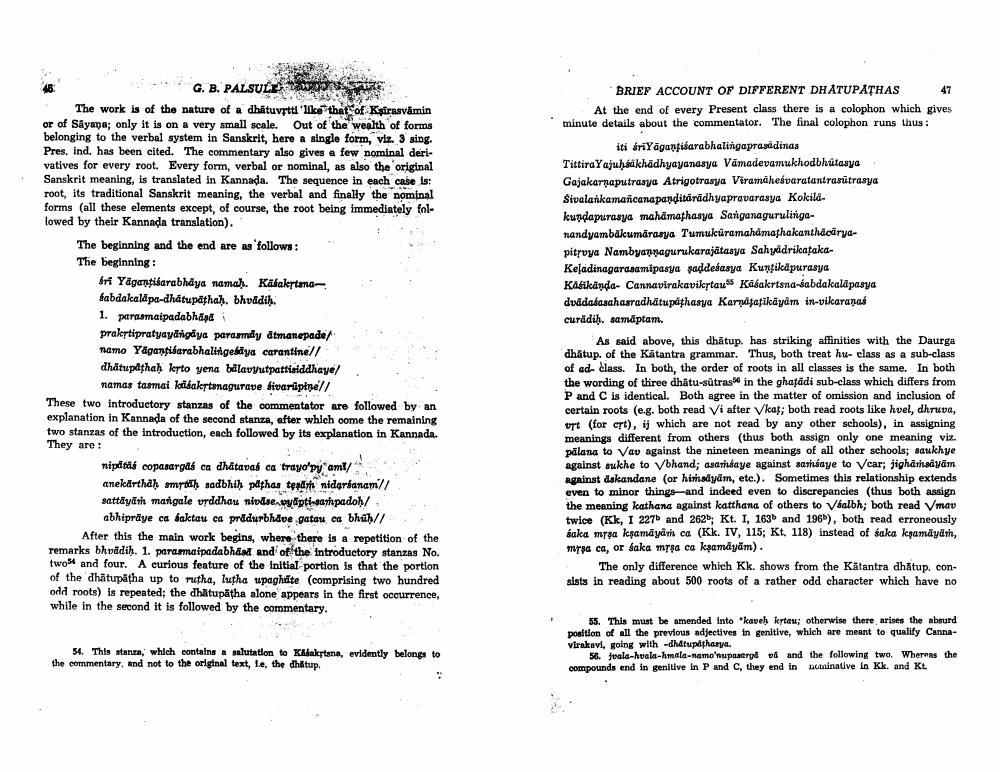Book Title: Brief Account Of Different Dhatupatras Author(s): G B Palsule Publisher: G B Palsule View full book textPage 6
________________ G. B. PALSULE 2002 The work is of the nature of a dhatuvytus that of Kpirasyämin or of Sayana; only it is on a very small scale. Out of the wealth of forms belonging to the verbal system in Sanskrit, here a single form, viz. 3 sing. Pres. ind. has been cited. The commentary also gives a few nominal derivatives for every root. Every form, verbal or nominal, as also the original Sanskrit meaning, is translated in Kannada. The sequence in each case is: root, its traditional Sanskrit meaning, the verbal and finally the nominal forms (all these elements except, of course, the root being immediately followed by their Kannada translation). The beginning and the end are as follows: The beginning: Sri Yagantisarabhaya namah. KätakstmaSabdakaldpa-dhatupathah. bhvadih. 1. parasmaipadabhāpai praktipratyayangiya parasmiy dtmanepade/ namo Yagantikarabhalisgesiya carantinel/ dhatupáthaḥ leto yena bilavyutpattiaiddhaye/ namas tasmai laidakstanagurave Sivardpłyel/ These two introductory stanzas of the commentator are followed by an explanation in Kannada of the second stanza, after which come the remaining two stanzas of the introduction, each followed by its explanation in Kannada. They are : nipdtas copasargas ca dhätavas ca trayo'py"amt/ anekärtha empoh sadbhih pdfhas tendit nidardanam// sattayari mangale vyddhau nivdswydpticaspadoh/ abhipraye ca saktau ca pradurbhave gatau ca bhat// After this the main work begins, where there is a repetition of the remarks bhvadih. 1. parc.emaipadabhast and of the introductory stanzas No. two and four. A curious feature of the initial portion is that the portion of the dhatupatha up to rutha, lutha upaghdte (comprising two hundred odd roots) is repeated; the dhatupatha alone appears in the first occurrence, while in the second it is followed by the commentary. BRIEF ACCOUNT OF DIFFERENT DHATUPATHAS 47 At the end of every Present class there is a colophon which gives minute details about the commentator. The final colophon runs thus: iti driYaganfisarabhalingaprasidinas TittiraYaju sikhädhyayanasya Vamadevamukhodbhutasya. Gajakarnaputrasya Atrigotrasya Viramihesvaratantrasitrasya Sivelankamaricanapanditdradhyapravarasya Kokilakundapurusya mahamathasya Sarganagurulisiganandyambakumarasya Tumukůramahamathakanthaedryapitsuya Nambyannagurukarajätasya SahyadrikatakaKeladinagarasamipasya paddesasya Kunfidpurasya Kasikinda- Cannavirakavikytaus Kasakrisna-labdakalápasya dvddašasahasradhatupashasya Karnatafikāyim in-vikaranas curadih. samāptam. As said above, this dhātup. has striking affinities with the Daurga dhätup. of the Katantra grammar. Thus, both treat hu- class as a sub-class of ad-class. In both, the order of roots in all classes is the same. In both the wording of three dhatu-sutras in the ghatādi sub-class which differs from P and C is identical. Both agree in the matter of omission and inclusion of certain roots (e.g. both read Vi after Vkat; both read roots like huel, dhruva, urt (for ert), which are not read by any other schools), in assigning meanings different from others (thus both assign only one meaning viz. pilana to Vav against the nineteen meanings of all other schools; saukhye against sukhe to Vbhand; asamudaye against sariaye to Vcar; fighdhadyam inst dakandane (or him.dydm, etc.). Sometimes this relationship extends even to minor things and indeed even to discrepancies (thus both assign the meaning kathans against katthans of others to Váalbh; both read Vmov twice (Kk, I 227 and 2626, Kt. I, 1636 and 1966), both read erroneously saka maa kşamdyth ca (Kk. IV, 115; Kt. 118) instead of saka kşamayath, musa ca, orsaka mia ca kepamdydm). The only difference which Kk. shows from the Kätantra dhatup. consists in reading about 500 roots of a rather odd character which have no 55. This must be amended Into kapeh kytau; otherwise there arises the absurd position of all the previous adjectives in genitive, which are meant to qualify Cannavirakovi, going with dhatupdharya 56. Juala-lala-mala-namonupasargd i and the following two. Whereas the compounds end In genitive in P and C, they end in baninative In K. and Kt. 54. This stane, which contains a salutation to Kikana, evidently belongs to the commentary, and not to the original text, Le, the dhatup.Page Navigation
1 ... 4 5 6 7 8 9
